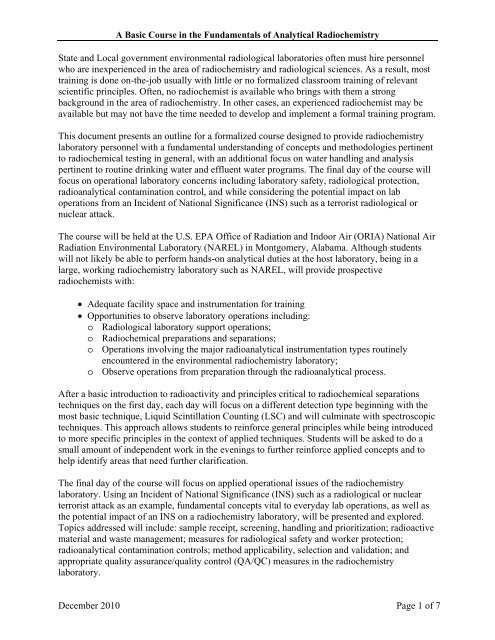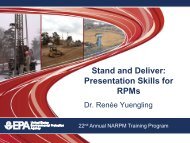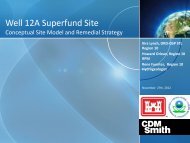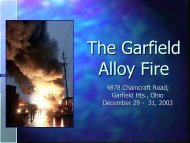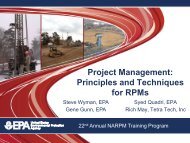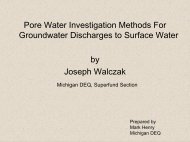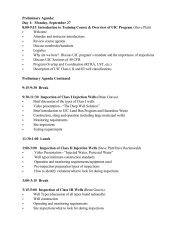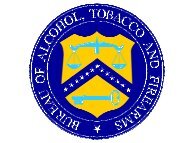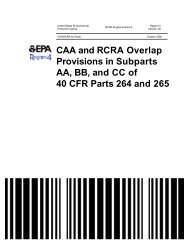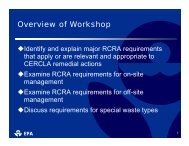A Basic Course in the Fundamentals of Analytical Radiochemistry ...
A Basic Course in the Fundamentals of Analytical Radiochemistry ...
A Basic Course in the Fundamentals of Analytical Radiochemistry ...
You also want an ePaper? Increase the reach of your titles
YUMPU automatically turns print PDFs into web optimized ePapers that Google loves.
A <strong>Basic</strong> <strong>Course</strong> <strong>in</strong> <strong>the</strong> <strong>Fundamentals</strong> <strong>of</strong> <strong>Analytical</strong> <strong>Radiochemistry</strong>State and Local government environmental radiological laboratories <strong>of</strong>ten must hire personnelwho are <strong>in</strong>experienced <strong>in</strong> <strong>the</strong> area <strong>of</strong> radiochemistry and radiological sciences. As a result, mosttra<strong>in</strong><strong>in</strong>g is done on-<strong>the</strong>-job usually with little or no formalized classroom tra<strong>in</strong><strong>in</strong>g <strong>of</strong> relevantscientific pr<strong>in</strong>ciples. Often, no radiochemist is available who br<strong>in</strong>gs with <strong>the</strong>m a strongbackground <strong>in</strong> <strong>the</strong> area <strong>of</strong> radiochemistry. In o<strong>the</strong>r cases, an experienced radiochemist may beavailable but may not have <strong>the</strong> time needed to develop and implement a formal tra<strong>in</strong><strong>in</strong>g program.This document presents an outl<strong>in</strong>e for a formalized course designed to provide radiochemistrylaboratory personnel with a fundamental understand<strong>in</strong>g <strong>of</strong> concepts and methodologies pert<strong>in</strong>entto radiochemical test<strong>in</strong>g <strong>in</strong> general, with an additional focus on water handl<strong>in</strong>g and analysispert<strong>in</strong>ent to rout<strong>in</strong>e dr<strong>in</strong>k<strong>in</strong>g water and effluent water programs. The f<strong>in</strong>al day <strong>of</strong> <strong>the</strong> course willfocus on operational laboratory concerns <strong>in</strong>clud<strong>in</strong>g laboratory safety, radiological protection,radioanalytical contam<strong>in</strong>ation control, and while consider<strong>in</strong>g <strong>the</strong> potential impact on laboperations from an Incident <strong>of</strong> National Significance (INS) such as a terrorist radiological ornuclear attack.The course will be held at <strong>the</strong> U.S. EPA Office <strong>of</strong> Radiation and Indoor Air (ORIA) National AirRadiation Environmental Laboratory (NAREL) <strong>in</strong> Montgomery, Alabama. Although studentswill not likely be able to perform hands-on analytical duties at <strong>the</strong> host laboratory, be<strong>in</strong>g <strong>in</strong> alarge, work<strong>in</strong>g radiochemistry laboratory such as NAREL, will provide prospectiveradiochemists with:• Adequate facility space and <strong>in</strong>strumentation for tra<strong>in</strong><strong>in</strong>g• Opportunities to observe laboratory operations <strong>in</strong>clud<strong>in</strong>g:o Radiological laboratory support operations;o Radiochemical preparations and separations;o Operations <strong>in</strong>volv<strong>in</strong>g <strong>the</strong> major radioanalytical <strong>in</strong>strumentation types rout<strong>in</strong>elyencountered <strong>in</strong> <strong>the</strong> environmental radiochemistry laboratory;o Observe operations from preparation through <strong>the</strong> radioanalytical process.After a basic <strong>in</strong>troduction to radioactivity and pr<strong>in</strong>ciples critical to radiochemical separationstechniques on <strong>the</strong> first day, each day will focus on a different detection type beg<strong>in</strong>n<strong>in</strong>g with <strong>the</strong>most basic technique, Liquid Sc<strong>in</strong>tillation Count<strong>in</strong>g (LSC) and will culm<strong>in</strong>ate with spectroscopictechniques. This approach allows students to re<strong>in</strong>force general pr<strong>in</strong>ciples while be<strong>in</strong>g <strong>in</strong>troducedto more specific pr<strong>in</strong>ciples <strong>in</strong> <strong>the</strong> context <strong>of</strong> applied techniques. Students will be asked to do asmall amount <strong>of</strong> <strong>in</strong>dependent work <strong>in</strong> <strong>the</strong> even<strong>in</strong>gs to fur<strong>the</strong>r re<strong>in</strong>force applied concepts and tohelp identify areas that need fur<strong>the</strong>r clarification.The f<strong>in</strong>al day <strong>of</strong> <strong>the</strong> course will focus on applied operational issues <strong>of</strong> <strong>the</strong> radiochemistrylaboratory. Us<strong>in</strong>g an Incident <strong>of</strong> National Significance (INS) such as a radiological or nuclearterrorist attack as an example, fundamental concepts vital to everyday lab operations, as well as<strong>the</strong> potential impact <strong>of</strong> an INS on a radiochemistry laboratory, will be presented and explored.Topics addressed will <strong>in</strong>clude: sample receipt, screen<strong>in</strong>g, handl<strong>in</strong>g and prioritization; radioactivematerial and waste management; measures for radiological safety and worker protection;radioanalytical contam<strong>in</strong>ation controls; method applicability, selection and validation; andappropriate quality assurance/quality control (QA/QC) measures <strong>in</strong> <strong>the</strong> radiochemistrylaboratory.December 2010 Page 1 <strong>of</strong> 7
About <strong>the</strong> Instructors:A <strong>Basic</strong> <strong>Course</strong> <strong>in</strong> <strong>the</strong> <strong>Fundamentals</strong> <strong>of</strong> <strong>Analytical</strong> <strong>Radiochemistry</strong>Anna Berne, Ph.D. is a nationally recognized expert <strong>in</strong> radiochemistry and radioanalytical methods,particularly <strong>in</strong> <strong>the</strong> field <strong>of</strong> radiochemical analysis <strong>of</strong> low-level environmental materials, with additional<strong>in</strong>terest <strong>in</strong> generat<strong>in</strong>g data <strong>of</strong> known and appropriate quality. Dur<strong>in</strong>g her 16 years at <strong>the</strong> EnvironmentalMeasurements Laboratory, she ga<strong>in</strong>ed expertise on an <strong>in</strong>ternational scale <strong>in</strong> <strong>the</strong> field <strong>of</strong> radiochemicalanalysis <strong>of</strong> low-level environmental materials, with additional <strong>in</strong>terest <strong>in</strong> generat<strong>in</strong>g data <strong>of</strong> known andappropriate quality. She has been responsible for radiochemical analysis <strong>of</strong> <strong>the</strong> Quality AssessmentProgram (QAP) Performance Evaluation (PE) samples, as well as analysis <strong>of</strong> samples for o<strong>the</strong>r nationaland <strong>in</strong>ternational programs, such as <strong>the</strong> Radiological Traceability Program (RTP, sponsored by <strong>the</strong>Department <strong>of</strong> Energy and <strong>the</strong> National Institute for Standards and Technology) and <strong>the</strong> InternationalAtomic Energy Agency <strong>in</strong>tercomparison programs. She has also been <strong>in</strong>volved <strong>in</strong> develop<strong>in</strong>g new radioanalyticalmethods at EML and presented <strong>the</strong> results <strong>of</strong> her work at national and <strong>in</strong>ternational meet<strong>in</strong>gsand conferences, such <strong>the</strong> annual Conference on Bioassay, <strong>Analytical</strong>, and Environmental<strong>Radiochemistry</strong> (BAER, currently called RRMC), <strong>the</strong> International Conference on Methods andApplications <strong>of</strong> Radioanalytical Chemistry (MARC) and The International Conference on RadionuclideMetrology and its Applications (ICRM). Dr. Berne is an active member <strong>in</strong> <strong>the</strong> ASTM Committee D19.Robert Litman, Ph.D. has been a researcher and practitioner <strong>of</strong> nuclear and radiochemical analysis for<strong>the</strong> past 34 years. He is well respected <strong>in</strong> <strong>the</strong> nuclear power <strong>in</strong>dustry as a specialist <strong>in</strong> radiochemistry andradiochemical <strong>in</strong>strumentation and plant systems corrosion. He authored <strong>the</strong> section <strong>of</strong> <strong>the</strong> EPRI PWRPrimary Water Chemistry Guidel<strong>in</strong>es on Radionuclides and has been a significant contributor to EPRIPrimary-to-Secondary Leak Detection Guidel<strong>in</strong>es. For <strong>the</strong> past four years, he has been <strong>the</strong> radiochemicalspecialist at <strong>the</strong> decommission<strong>in</strong>g <strong>of</strong> <strong>the</strong> Yankee Rowe Nuclear Power Station for water and soilanalytical sampl<strong>in</strong>g and analysis. He has co-authored two chapters <strong>of</strong> MARLAP, and is currently one <strong>of</strong> ateam <strong>of</strong> specialists present<strong>in</strong>g MARLAP tra<strong>in</strong><strong>in</strong>g. His areas <strong>of</strong> technical expertise are gammaspectroscopy and radiochemical separations. Dr. Litman has been teach<strong>in</strong>g courses <strong>in</strong> <strong>Radiochemistry</strong>and related special areas for <strong>the</strong> past 18 years.Robert Shannon is recognized as a national expert <strong>in</strong> environmental radiochemistry and radiobioassay,radioanalytical laboratory management and QA/QC, and method, laboratory and <strong>in</strong>formation systemsdevelopment. His <strong>in</strong>timate familiarity with <strong>the</strong> methods, techniques and protocols <strong>of</strong> environmentalradiochemistry stems from years <strong>of</strong> applied laboratory experience. He has served as technical directorand radiochemistry manager with several commercial laboratories, as deputy manager <strong>of</strong> <strong>the</strong> on-sitelaboratories, and <strong>Radiochemistry</strong> and Radiobioassay Subject Matter Expert at <strong>the</strong> Rocky FlatsEnvironmental Technology Site, CO and is a radiochemistry auditor with <strong>the</strong> Department <strong>of</strong> EnergyConsolidated Audit Program (DOECAP). Mr. Shannon contributes extensively to methods, standards andQA system development activities with ASTM Committees D19 and C26, Standard Methods for <strong>the</strong>Exam<strong>in</strong>ation <strong>of</strong> Water and Wastewater and is a member <strong>of</strong> <strong>the</strong> Health Physics Society and <strong>the</strong> AmericanChemical Society. In 2003, he received <strong>the</strong> RRM/BAER (Radiobioassay & Radiochemical Measurements/Bioassay,<strong>Analytical</strong>, and Environmental <strong>Radiochemistry</strong> Conference) Conference FoundersAward.December 2010 Page 2 <strong>of</strong> 7
A <strong>Basic</strong> <strong>Course</strong> <strong>in</strong> <strong>the</strong> <strong>Fundamentals</strong> <strong>of</strong> <strong>Analytical</strong> <strong>Radiochemistry</strong>PROJECTED COURSE OUTLINEWelcome and Introductions1. Introduction to Radioactivitya. Forms <strong>of</strong> radioactive decayb. Types <strong>of</strong> particles emitted <strong>in</strong> radioactive decayc. Interactions <strong>of</strong> radioactivity with matterd. <strong>Basic</strong> radioactive decay law and calculation <strong>of</strong> simple decaye. Units <strong>of</strong> radioactivity and radioactivity concentrationf. Natural cha<strong>in</strong> decay relationships impact<strong>in</strong>g presence and measurement <strong>of</strong>commonly-encountered, regulated natural and anthropogenic radionuclidesg. Examples <strong>of</strong> decay cha<strong>in</strong>s and radioactive equilibrium2. Liquid Sc<strong>in</strong>tillation Count<strong>in</strong>g – Theory <strong>of</strong> Analysisa. Typical uses – strengths and limitationsb. Instrument <strong>the</strong>ory and operationc. Detection efficiency (response)d. Background activitye. <strong>Basic</strong> equations for determ<strong>in</strong><strong>in</strong>g radioactivity from count data3. Tritium Analysis by Liquid Sc<strong>in</strong>tillation Count<strong>in</strong>g (EPA Method 906.0)a. Natural and anthropogenic sources <strong>of</strong> tritiumb. Regulatory background (Safe Dr<strong>in</strong>k<strong>in</strong>g Water Act-SDWA)c. Scope and application -typical used. EPA Method 906.0 summarye. Sample preparationf. Radioanalysisg. Typical LSC problems and method <strong>in</strong>terferences; Quenchh. Example calculations4. Pr<strong>in</strong>ciples <strong>of</strong> Radiochemical Separationsa. Radiometric Measurements and Interferencesb. Solubility and precipitationc. Oxidation and reductiond. Complexatione. Solvent extraction and ion exchangef. Carriers and tracers5. Gas-Filled Detectors and Gas Flow Proportional Count<strong>in</strong>g (GPC)a. Typical use – strengths and limitationsDecember 2010 Page 3 <strong>of</strong> 7
A <strong>Basic</strong> <strong>Course</strong> <strong>in</strong> <strong>the</strong> <strong>Fundamentals</strong> <strong>of</strong> <strong>Analytical</strong> <strong>Radiochemistry</strong>b. Instrument <strong>the</strong>ory and operationc. Instrument set-upd. Background quantification and correctionse. Detector calibrationsf. Common problems and <strong>in</strong>terferences6. Measurement <strong>of</strong> Gross Alpha and Beta Radioactivity (EPA Method 900.0)a. Natural and anthropogenic sources <strong>of</strong> alpha and beta emittersb. Regulatory background (SDWA)c. Scope and application - typical used. EPA Method 900.0 summarye. Sample preparationf. Radioanalysisg. Typical GPC problems and <strong>in</strong>terferencesh. Calculation <strong>of</strong> example result7. Radium-228 Analysis (EPA Method 904.0)a. Natural and anthropogenic sources <strong>of</strong> Ra-228b. Regulatory background (SDWA)c. Scope and application - typical used. EPA Method 904.0 summarye. Sample preparationf. Radioanalysisg. Example calculations8. Alpha Spectrometrya. Instrument <strong>the</strong>ory and operationb. Typical uses – strengths and limitationsc. Detector Calibrationd. Alpha Spectral Featurese. Background activityf. <strong>Basic</strong> equations for determ<strong>in</strong><strong>in</strong>g radioactivity from count data9. Isotopic Uranium by Alpha Spectrometry (ASTM Method D3972)a. Natural and anthropogenic sources <strong>of</strong> alpha emittersb. Regulatory background (SDWA)c. Scope and application - typical used. Overview EPA Method 908.0e. Review ASTM Method D3972f. Sample preparationDecember 2010 Page 4 <strong>of</strong> 7
A <strong>Basic</strong> <strong>Course</strong> <strong>in</strong> <strong>the</strong> <strong>Fundamentals</strong> <strong>of</strong> <strong>Analytical</strong> <strong>Radiochemistry</strong>g. Radioanalysish. Common problems and <strong>in</strong>terferencesi. Calculations10. Sample Preservation and Sample Pretreatment and Preparationa. Types <strong>of</strong> samples expected by a laboratoryb. Purpose <strong>of</strong> sample preservationc. Preservation techniquesd. Ma<strong>in</strong>ta<strong>in</strong><strong>in</strong>g sample <strong>in</strong>tegrity dur<strong>in</strong>g sample preparatione. Techniques and strategies for sample dissolution11. Statistics Unique to Radiochemical Applicationsa. Estimation and report<strong>in</strong>g <strong>of</strong> uncerta<strong>in</strong>ty <strong>in</strong> radiochemical analysis,b. Count<strong>in</strong>g uncerta<strong>in</strong>tyc. Count<strong>in</strong>g uncerta<strong>in</strong>ty vs. comb<strong>in</strong>ed standard uncerta<strong>in</strong>tyd. SDWA ‘Detection Limit’e. Critical level concentrationf. M<strong>in</strong>imum detectable activity and concentrationg. SDWA ‘Detection Limit’12. Radium-226 by Alpha Sc<strong>in</strong>tillation (EPA Method 903.1)a. Typical uses – strengths and limitationsb. Instrument <strong>the</strong>ory and operationc. Detection efficiency (response)d. Background activitye. Natural and anthropogenic sources <strong>of</strong> Ra-226f. Regulatory background (SDWA)g. Scope and application - typical useh. Review EPA Method 903.1i. Sample preparationj. Radioanalysisk. Calculations13. Gamma Spectrometrya. Typical uses – strengths and limitationsb. Instrument <strong>the</strong>ory and operationc. Spectral featuresd. Detection efficiency (response)e. Background activityf. <strong>Basic</strong> equations for determ<strong>in</strong><strong>in</strong>g radioactivity from count dataDecember 2010 Page 5 <strong>of</strong> 7
A <strong>Basic</strong> <strong>Course</strong> <strong>in</strong> <strong>the</strong> <strong>Fundamentals</strong> <strong>of</strong> <strong>Analytical</strong> <strong>Radiochemistry</strong>14. Gamma Spectrometry (EPA 901.0)a. Natural and anthropogenic sources <strong>of</strong> gamma emittersb. Regulatory background (SDWA)c. Scope and application - typical used. Libraries and spectral analysise. Review EPA Method 901.0f. Common problems and <strong>in</strong>terferences15. Quality Assurance (QA) <strong>in</strong> Radiochemical Analysis Overview <strong>of</strong> Requirements for<strong>the</strong> Laboratorya. Laboratory QA plan / manualb. Laboratory documents and recordsc. Method validationd. Tra<strong>in</strong><strong>in</strong>g and demonstration <strong>of</strong> analyst capabilitiese. Ma<strong>in</strong>ta<strong>in</strong><strong>in</strong>g cha<strong>in</strong> <strong>of</strong> custodyf. Auditsg. Preventive ma<strong>in</strong>tenanceh. Corrective actionsi. Data reduction and report<strong>in</strong>gj. Data review16. Quality Assurance for Standards and Equipment (Non-Count<strong>in</strong>g) <strong>in</strong> RadiochemicalAnalysisa. Label<strong>in</strong>g, sample flow and sample track<strong>in</strong>g practicesb. Sample preservation and preparationc. Statistical process controld. Batch conceptse. Batch QC sample evaluationf. Performance test<strong>in</strong>g programsg. Sample specific quality <strong>in</strong>dicat<strong>in</strong>g parametersh. Batch QC sample evaluation17. Concepts and Recommendations for a Radiation Incident <strong>of</strong> National Significancea. Radioanalytical Needs Follow<strong>in</strong>g a Radiation Incidentb. Directed Exercise: Introduction <strong>of</strong> Dr<strong>in</strong>k<strong>in</strong>g Water Contam<strong>in</strong>ation Scenario(Sample Control)c. The Data Quality Objectives / Measurement Quality Objectives (DQO/MQO)Processd. Methods for Incident Response ApplicationsDecember 2010 Page 6 <strong>of</strong> 7
A <strong>Basic</strong> <strong>Course</strong> <strong>in</strong> <strong>the</strong> <strong>Fundamentals</strong> <strong>of</strong> <strong>Analytical</strong> <strong>Radiochemistry</strong>e. Directed Exercise: Cont<strong>in</strong>uation <strong>of</strong> Dr<strong>in</strong>k<strong>in</strong>g Water Contam<strong>in</strong>ation Scenario(Sample Screen<strong>in</strong>g and Handl<strong>in</strong>g)f. Radiation Protection and Contam<strong>in</strong>ation Control <strong>in</strong> a <strong>Radiochemistry</strong> Laboratoryg. Ma<strong>in</strong>ta<strong>in</strong><strong>in</strong>g Quality Control Dur<strong>in</strong>g Incident Response Operationsh. Manag<strong>in</strong>g Operational Resources dur<strong>in</strong>g Incident Responsei. Incident Response Laboratory Analysis: Protocol Paradigm Shift?j. Directed Exercise: Prioritization <strong>of</strong> Samples through Scenario IDecember 2010 Page 7 <strong>of</strong> 7


